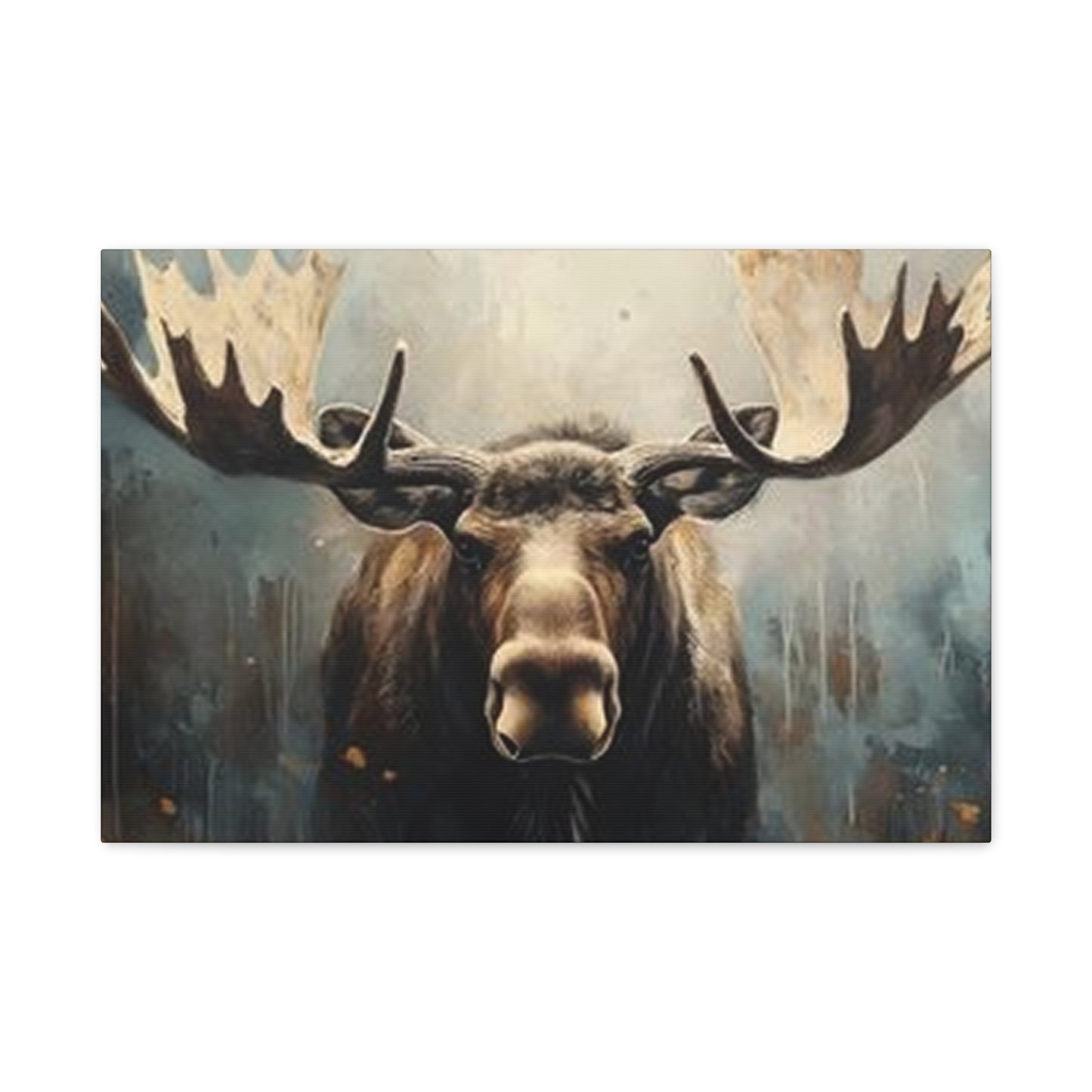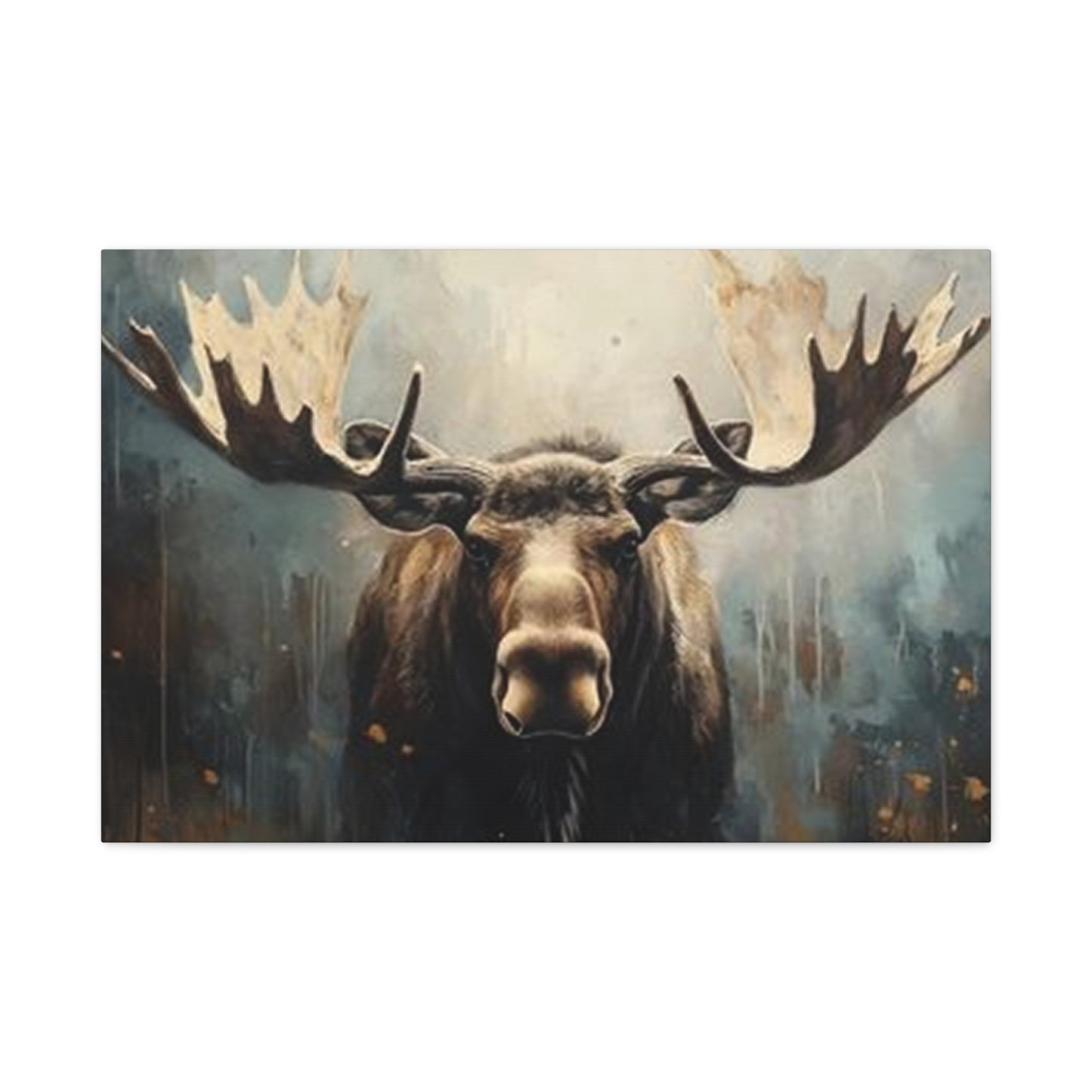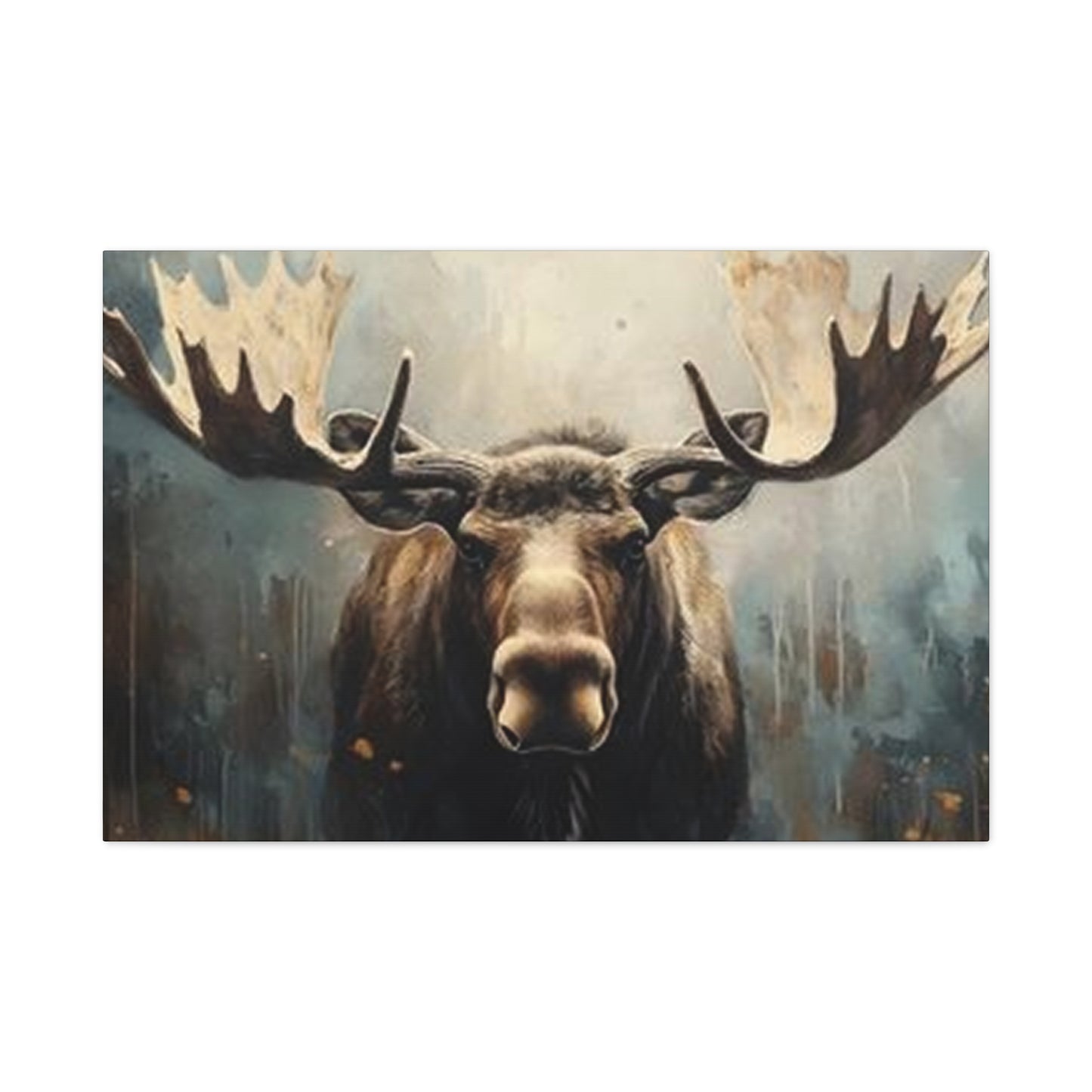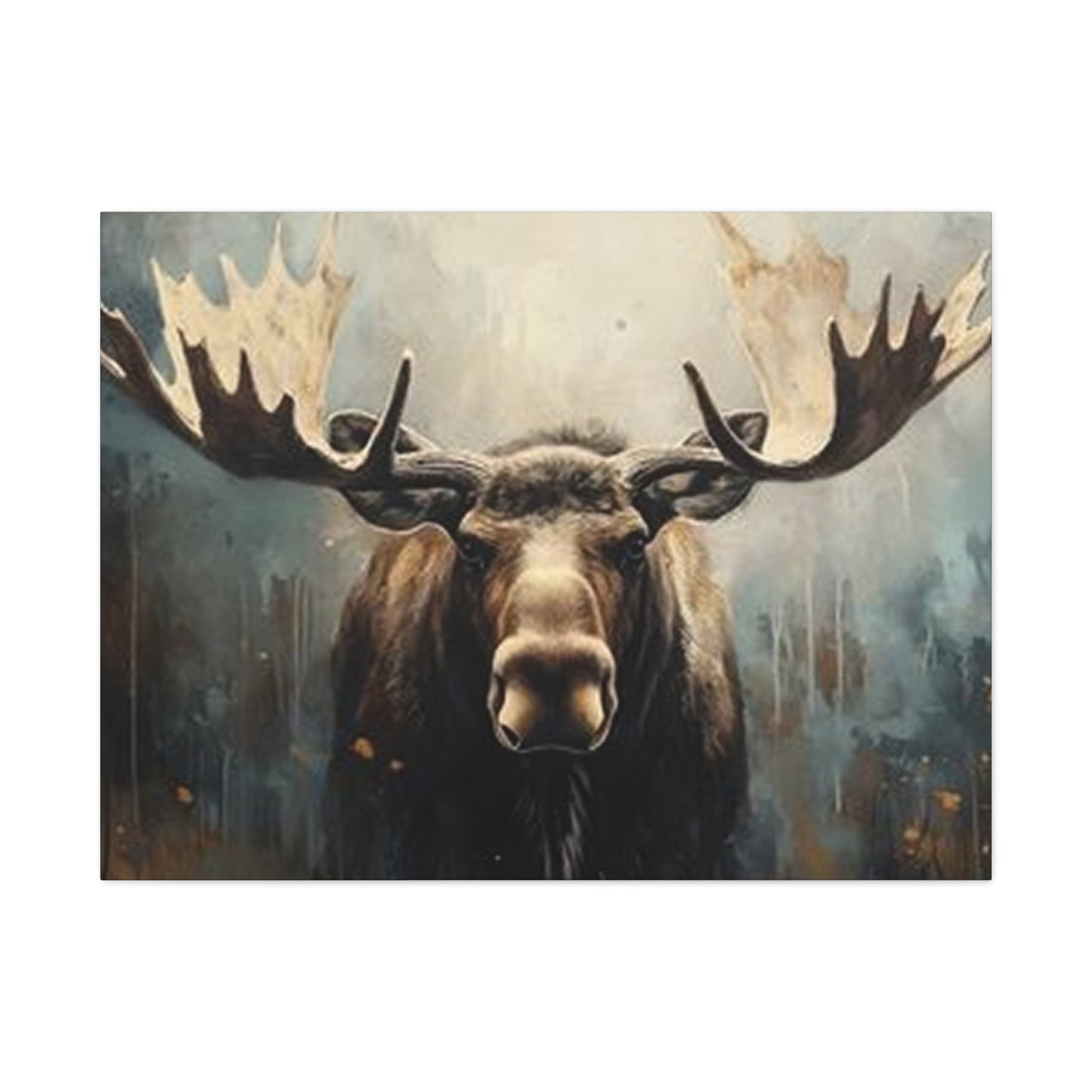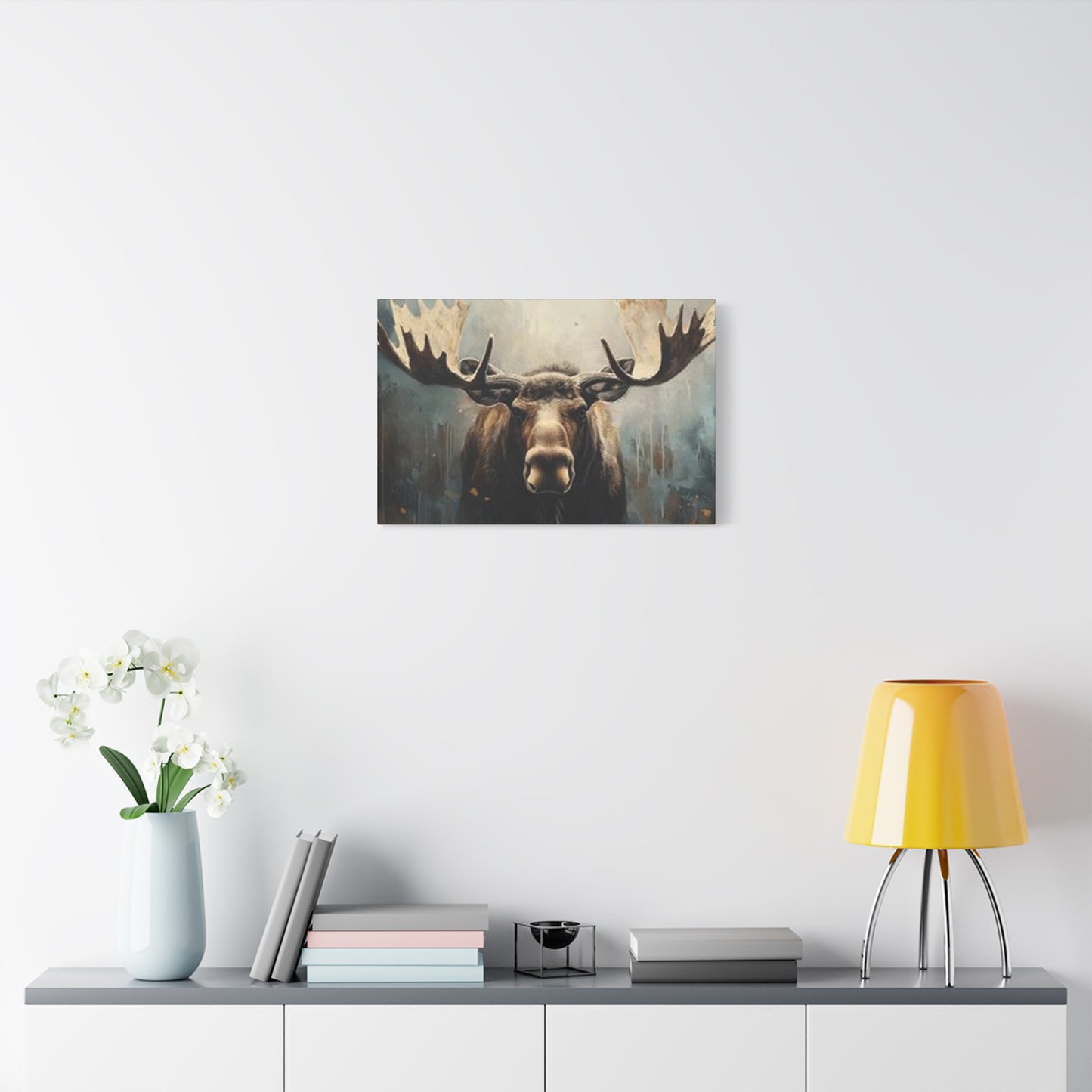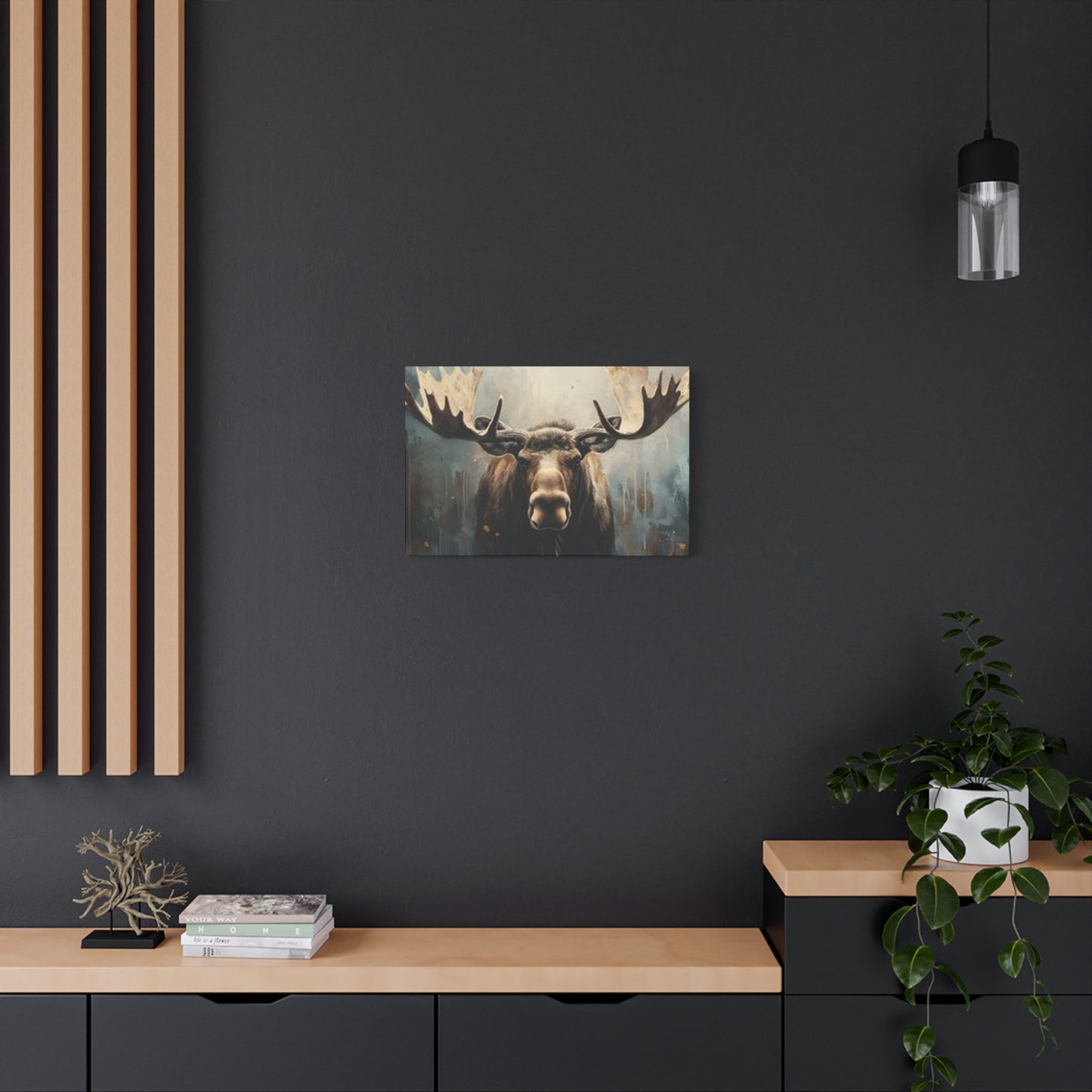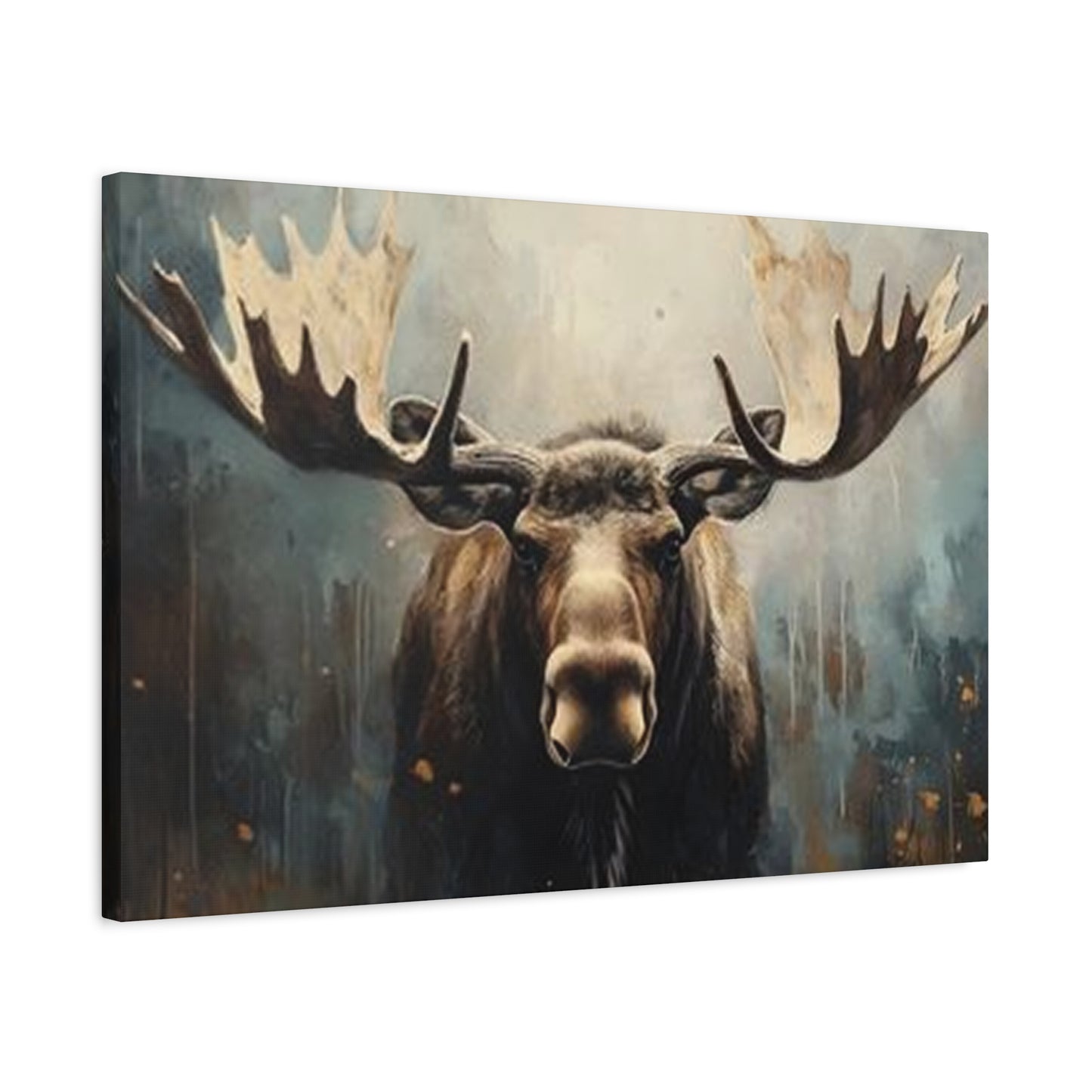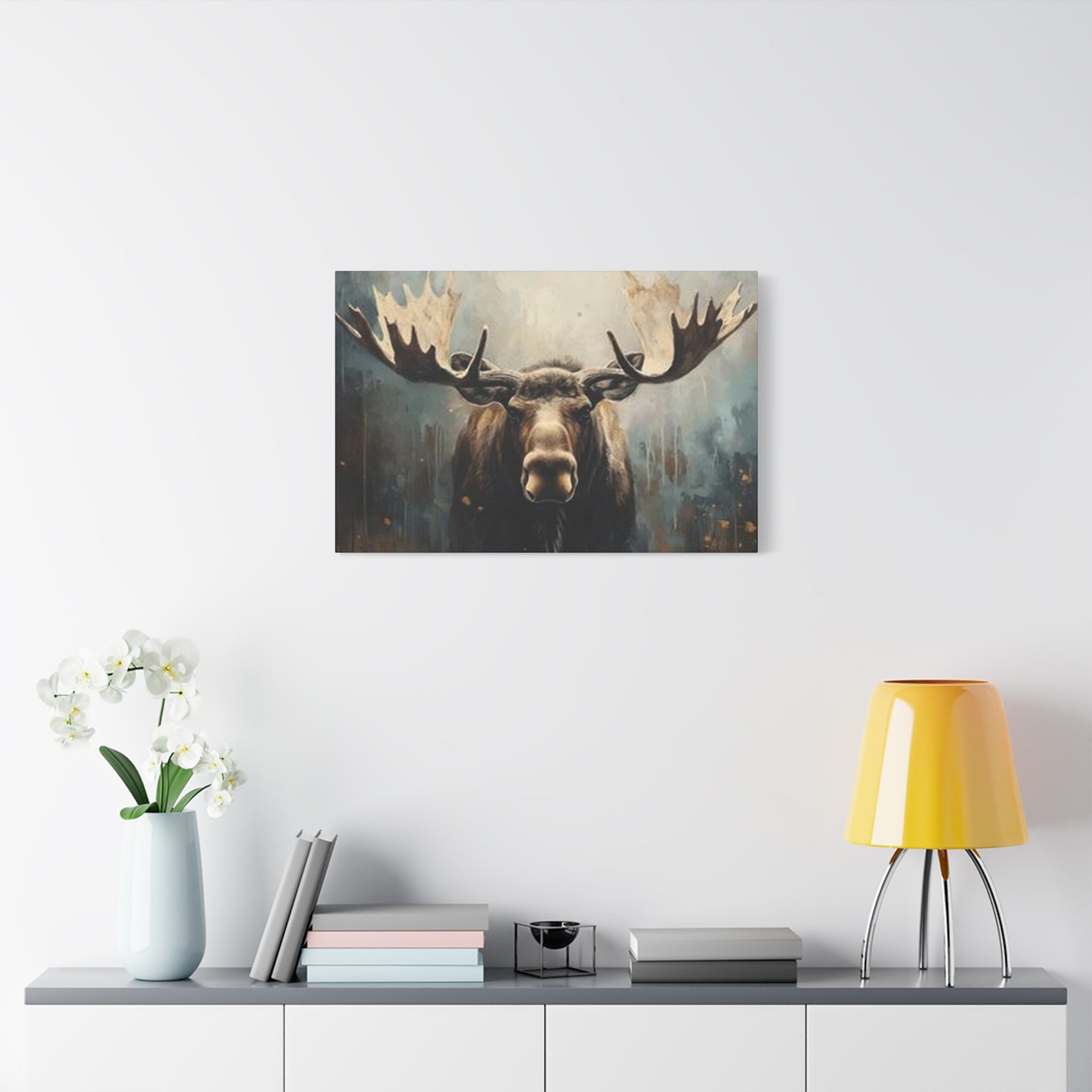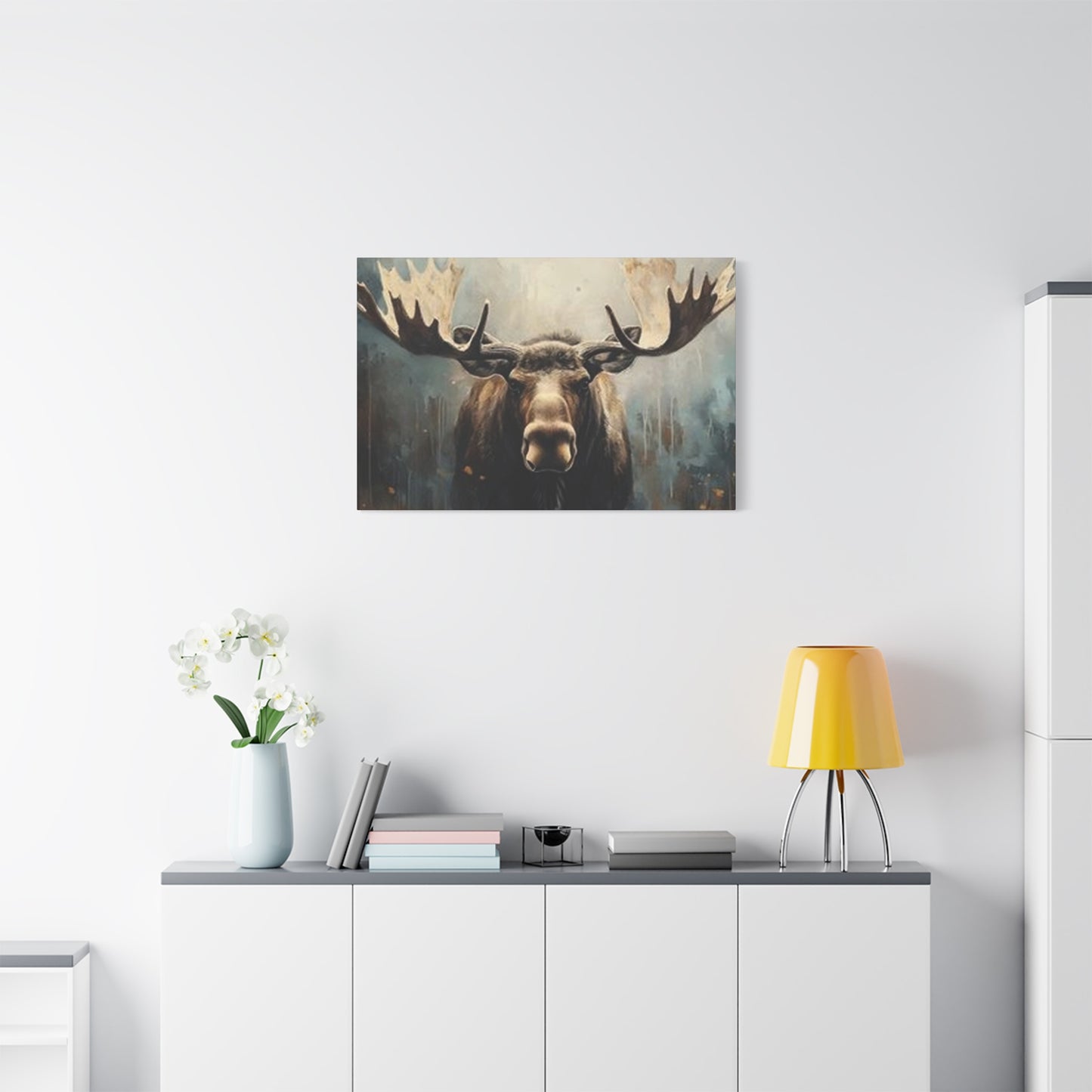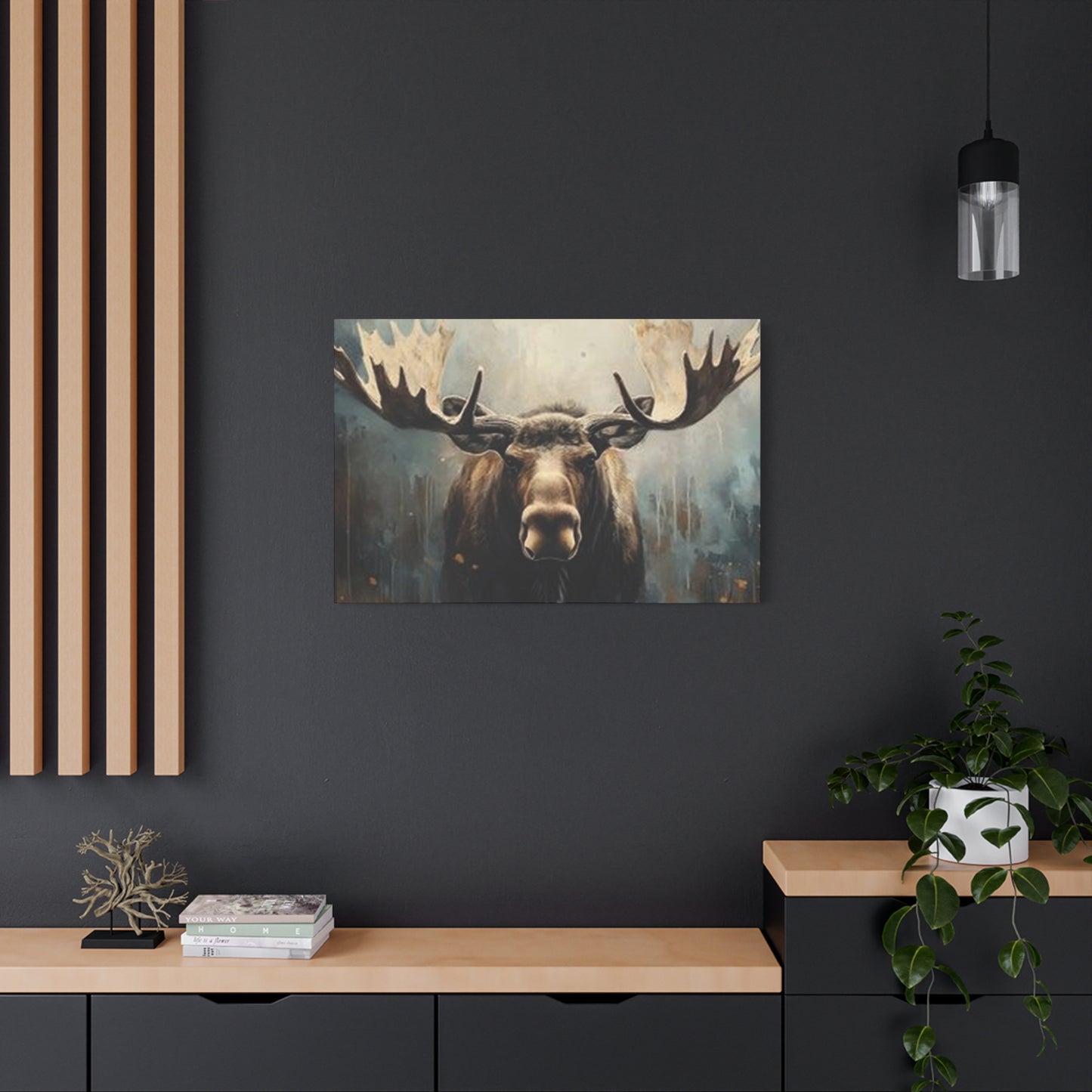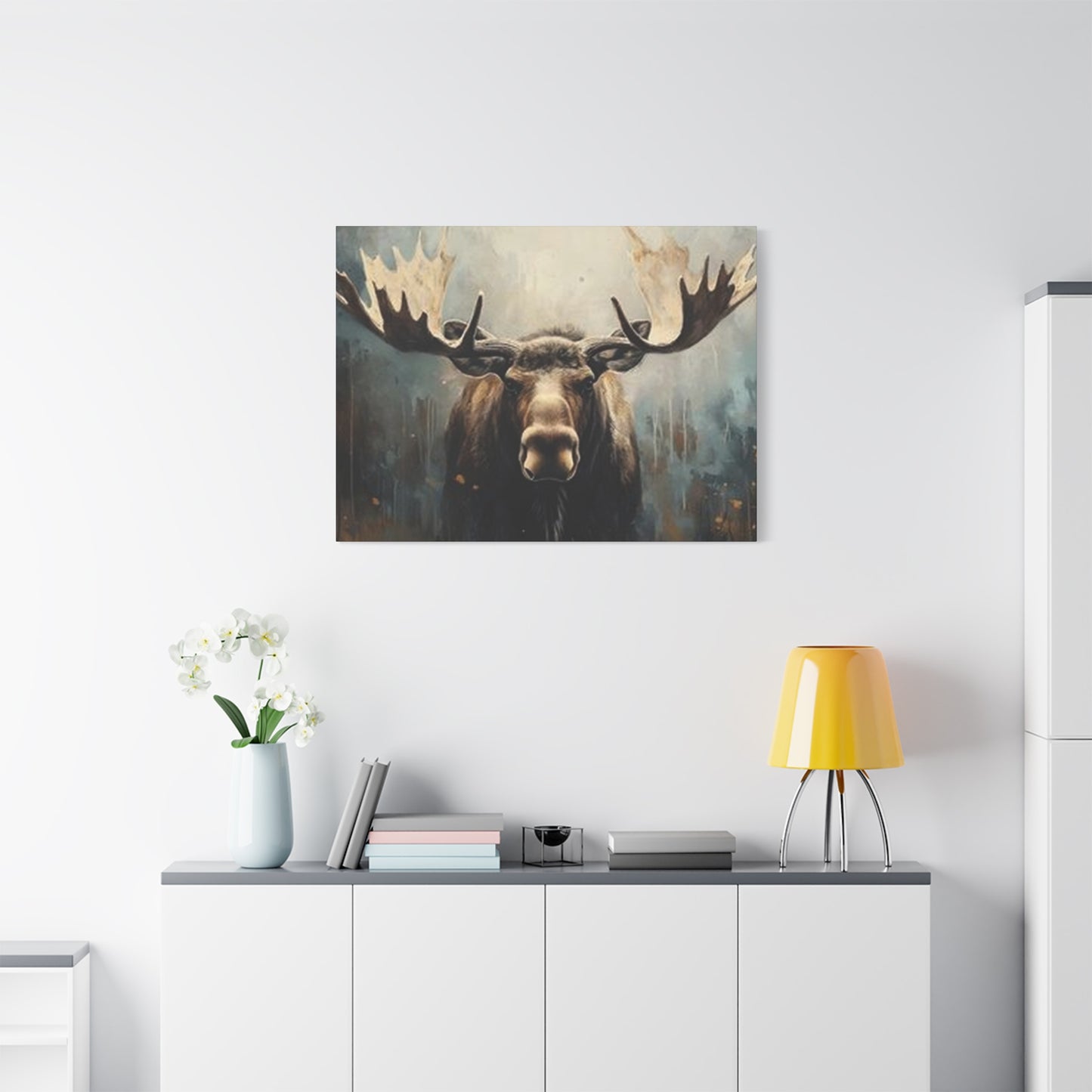Wildlife Elegance: A Complete Guide to Moose Painting Wall Art for Your Living Space
Bringing the essence of untamed wilderness into your living space has become an increasingly popular design choice among homeowners and interior decorators alike. The magnificence of wildlife artwork, particularly featuring the iconic moose, offers a unique opportunity to infuse natural grandeur into residential and commercial environments. These powerful creatures, native to northern forests and characterized by their impressive antlers and commanding presence, have captured the imagination of artists and nature enthusiasts for generations. Through carefully crafted canvas paintings and decorative pieces, you can transform ordinary walls into captivating focal points that celebrate the raw beauty of nature while maintaining sophisticated aesthetic appeal.
The rising popularity of wildlife-themed interior design reflects a broader cultural shift toward reconnecting with natural environments, especially among urban dwellers seeking refuge from concrete landscapes. Large-scale animal portraits serve multiple purposes beyond mere decoration, functioning as conversation starters, mood enhancers, and statements of personal values regarding environmental conservation. When selecting artwork featuring these majestic forest dwellers, considerations extend far beyond simple aesthetic preference, encompassing factors such as room dimensions, existing color schemes, lighting conditions, and the overall atmosphere you wish to create within your space.
Capturing the Essence of Northern Forest Giants Through Visual Art
The artistic representation of these magnificent creatures has evolved dramatically over centuries, progressing from simple naturalistic depictions to sophisticated interpretations that blend realism with contemporary design sensibilities. Traditional portrayals often emphasized anatomical accuracy and behavioral documentation, serving educational purposes while celebrating the animal's inherent nobility. Modern interpretations, however, have expanded the creative boundaries, incorporating abstract elements, unexpected color palettes, and innovative compositional techniques that transform wildlife imagery into genuine fine art worthy of gallery exhibition.
Artists working in this specialized niche must possess both technical proficiency and deep understanding of their subject matter. Successful wildlife painters often spend considerable time observing these animals in their natural habitats, studying their movement patterns, seasonal coat variations, and characteristic postures. This intimate knowledge translates into artwork that captures not merely physical appearance but the essential spirit and personality of the species. The subtle tilt of a head, the alert positioning of ears, the powerful stance of legs braced against wilderness terrain all these details contribute to creating images that resonate with authenticity and emotional impact.
Contemporary wildlife art has also embraced diverse stylistic approaches, ranging from hyperrealistic renderings that rival photography in detail to impressionistic interpretations that prioritize mood and atmosphere over precise representation. Some artists favor dramatic lighting effects that cast their subjects in theatrical shadows and highlights, while others prefer the gentle illumination of forest clearings on misty mornings. Color treatments vary equally, with some creators maintaining naturalistic earth tones while others experiment boldly with jewel tones, metallic accents, or even monochromatic schemes that emphasize form and texture over conventional coloration.
The technical execution of large-scale wildlife paintings presents unique challenges that distinguish this art form from other genres. Canvas selection becomes crucial when working with substantial dimensions, as the material must withstand stretching without warping while providing an appropriate surface texture for the chosen medium. Oil paints offer rich color saturation and extended working time that facilitates detailed rendering, but require lengthy drying periods and proper ventilation during creation. Acrylic alternatives dry rapidly and produce vibrant hues, though they demand swift, confident execution and different blending techniques. Some contemporary artists even incorporate mixed media elements, combining traditional painting with digital enhancements or physical textures that add dimensional interest to finished pieces.
Transforming Living Spaces with Authentic Wilderness Character
Incorporating substantial wildlife artwork into residential interiors requires thoughtful planning and consideration of multiple environmental factors. The relationship between artwork dimensions and wall space follows principles similar to furniture scaling, where oversized pieces in compact rooms can create oppressive feelings while undersized art in expansive areas appears insignificant and lost. General guidelines suggest that artwork should occupy roughly two-thirds to three-quarters of available wall space to achieve visual balance, though this ratio adjusts based on ceiling height, adjacent furnishings, and architectural features such as windows or built-in shelving.
Placement height significantly impacts viewer experience and perceived room proportions. Standard gallery hanging positions center artwork at approximately 57 to 60 inches from floor level, corresponding to average eye height and ensuring comfortable viewing without neck strain. However, this guideline requires adjustment when dealing with particularly large canvases or unusual room configurations. Above furniture pieces, artwork should float with adequate breathing room, typically maintaining 6 to 12 inches of clearance above sofas, consoles, or beds to establish visual connection without creating cramped spacing.
The interplay between natural and artificial lighting dramatically affects how wildlife artwork appears throughout daily cycles. North-facing walls receive consistent, cool-toned illumination that minimizes color distortion and glare, making them ideal for displaying valuable pieces sensitive to ultraviolet degradation. South-facing positions benefit from abundant natural light but require protective measures such as UV-filtering glass or strategic curtain use to prevent fading. Artificial lighting design should incorporate adjustable spotlights or picture lights that can be fine-tuned to enhance dimensional qualities and color richness without creating distracting reflections on canvas surfaces.
Color coordination between wildlife artwork and existing décor elements requires balancing harmony with intentional contrast. Earth-tone palettes featuring browns, deep greens, warm grays, and cream shades naturally complement imagery of forest-dwelling creatures, creating cohesive schemes that feel organic and restful. However, introducing unexpected accent colors through throw pillows, area rugs, or decorative accessories can prevent monotony while drawing attention to specific artwork elements. Metallic finishes in gold, bronze, or copper tones particularly resonate with antler imagery and autumn forest settings, adding subtle sophistication without overwhelming natural themes.
Texture plays an equally important role in successful wildlife-themed room design. Combining smooth painted walls with rough-hewn wood furnishings, woven textiles, and stone or slate accents creates tactile variety that echoes the diverse surfaces found in natural environments. Leather upholstery, wool throws, linen curtains, and jute area rugs all contribute authentic material qualities that reinforce connections to wilderness aesthetics. These textural layers prevent spaces from feeling flat or one-dimensional, instead building visual interest that encourages extended observation and appreciation.
Creating Comfortable Retreats with Forest-Inspired Aesthetics
The concept of transforming residential spaces into personal sanctuaries has gained tremendous momentum as modern life grows increasingly hectic and digitally dominated. Wildlife artwork featuring impressive northern mammals serves as powerful anchoring elements in these refuge-like environments, providing focal points that encourage mental retreat into imagined wilderness settings. The psychological benefits of nature imagery have been extensively documented, with research demonstrating measurable reductions in stress hormones, blood pressure, and anxiety levels among individuals regularly exposed to natural scenes and wildlife representations.
Designing cozy, inviting interiors around substantial animal portraits begins with establishing appropriate foundational elements. Flooring materials set important tonal precedents, with hardwood planks in medium to dark stains evoking forest floors while providing durable, timeless surfaces that accommodate various decorating styles. Area rugs define conversation zones while adding warmth underfoot, with options ranging from traditional Persian patterns to modern geometric designs or nature-inspired motifs featuring leaves, branches, or abstract landscape elements. The key lies in selecting pieces that complement rather than compete with wall art, supporting the overall design narrative without fragmenting visual attention.
Furniture selection for wildlife-themed spaces typically favors substantial, well-constructed pieces that convey permanence and quality. Overstuffed sofas and armchairs upholstered in durable fabrics invite relaxation while providing comfortable viewing positions for artwork appreciation. Coffee tables and side tables crafted from reclaimed wood, live-edge slabs, or distressed finishes introduce authentic rustic character without sacrificing functionality. Storage solutions incorporating natural materials such as wicker baskets, wooden crates, or leather-strapped trunks maintain thematic consistency while addressing practical organizational needs.
Window treatments in wildlife-decorated rooms balance privacy requirements with desire for natural light and outdoor views. Heavy drapes in textured fabrics like burlap, canvas, or wool felt provide insulation and light control while contributing to cozy atmospheres, particularly important in colder climates where these northern animals naturally thrive. Layering options with sheer panels allows flexible adjustment throughout the day, admitting diffused morning light while maintaining ability to darken spaces for evening relaxation. Hardware selections in wrought iron, dark bronze, or natural wood finishes reinforce rustic sensibilities while ensuring smooth operation and long-term durability.
Accessorizing wildlife-themed interiors requires restraint and intentionality to avoid veering into kitsch territory. Rather than overwhelming spaces with numerous small animal figurines or decorative items, focus on fewer, higher-quality pieces that meaningfully contribute to the overall design story. A strategically placed antler chandelier or wall-mounted rack serves both functional and aesthetic purposes. Handcrafted ceramics in earth tones, vintage leather-bound books, and natural fiber baskets add authentic character without cluttering surfaces. Fresh greenery through potted plants or seasonal branches brings living elements that echo the outdoor environments depicted in wall art.
Understanding the Visual Power of Antlered Majesty
The distinctive physical characteristics of these impressive northern mammals make them particularly compelling subjects for artistic interpretation and home décor. Their massive antlers, which can span up to six feet in width on mature males, create dramatic silhouettes that command attention and provide endless fascination for observers. These magnificent cranial structures, shed and regrown annually, have captivated human imagination throughout history, appearing in cultural traditions, folklore, and spiritual practices across numerous societies inhabiting northern regions.
Artists approaching these animals as subjects must grapple with representing their unique combination of grace and power. Despite massive body proportions that can exceed 1,500 pounds, they move through dense forest undergrowth with surprising agility and near-silent footfalls. This paradoxical quality presents interesting creative challenges, as effective portrayals must convey both physical strength and inherent dignity. Successful artwork captures the alert intelligence visible in their eyes, the textured quality of their coats as they transition through seasonal variations, and the careful poise of their movements through challenging terrain.
Compositional choices significantly impact how viewers experience animal portraits. Close-up perspectives emphasizing facial features and antler details create intimate encounters that highlight individual personality and character. These tightly cropped compositions work exceptionally well in smaller spaces or as parts of gallery wall arrangements where they can be paired with complementary images. Medium-range portrayals showing full body structure within environmental context provide narrative elements and sense of place, helping viewers imagine the creature within its natural habitat. Distant landscape views with animals as smaller elements embedded within expansive wilderness scenes emphasize scale relationships and environmental grandeur rather than individual specimen details.
Seasonal variations offer rich opportunities for artistic exploration and allow collectors to rotate displayed pieces throughout the year, maintaining fresh visual interest. Spring imagery might feature younger animals with developing antlers against backgrounds of emerging foliage and rushing snowmelt streams. Summer scenes showcase animals in full coat feeding on aquatic vegetation in calm lake shallows, with lush greenery providing vibrant color contrasts. Autumn representations, perhaps most popular for their dramatic visual qualities, present animals during mating season with fully developed antlers, set against blazing foliage in golds, oranges, and deep reds. Winter compositions emphasize stark beauty, with dark silhouettes standing bold against snow-covered landscapes under gray skies or clear starlit nights.
The symbolic resonance of these northern forest dwellers extends across numerous cultural contexts, adding layers of meaning beyond pure aesthetic appreciation. Indigenous peoples throughout North America and Northern Europe have long regarded these animals with deep respect, recognizing their importance as food sources, material providers, and spiritual guides. Many traditions associate them with strength, endurance, wisdom, and connection to ancient natural rhythms. Contemporary homeowners drawn to wildlife imagery often respond to these archetypal associations, even when not consciously aware of deeper symbolic meanings embedded in cultural memory.
Embracing Clean Lines and Northern European Design Principles
The aesthetic movement originating in Northern European countries has profoundly influenced contemporary interior design, offering refreshing alternatives to ornate traditional styles or stark industrial minimalism. This design philosophy emphasizes simplicity, functionality, connection to nature, and quality craftsmanship, principles that align beautifully with wildlife artwork featuring northern forest inhabitants. The resulting spaces feel simultaneously modern and timeless, combining clean architectural lines with warm natural materials and carefully curated decorative elements that celebrate rather than dominate their surroundings.
Color palettes associated with this design approach typically feature neutral foundations in whites, soft grays, and pale woods, punctuated by accent colors drawn from natural sources such as deep forest greens, slate blues, warm terracottas, and golden yellows. These subdued schemes create calming environments that showcase featured artwork without visual competition. Wildlife paintings provide ideal accent pieces within these restrained color contexts, their earth-tone subjects harmonizing with neutral backgrounds while darker frames or mounting systems create crisp definition that satisfies the style's preference for clear delineation.
Furniture silhouettes in this aesthetic tradition favor streamlined forms without excessive ornamentation, constructed from high-quality materials with visible grain patterns and natural finishes. Light-colored woods including birch, pine, ash, and beech predominate, their pale tones maintaining visual spaciousness while introducing warmth that prevents cold institutional feelings. Upholstery typically features solid colors or simple patterns rather than busy prints, with linen and wool being preferred fabric choices for their natural origins and attractive textural qualities. The overall effect creates peaceful, uncluttered environments where each element receives proper attention and appreciation.
Lighting design within this framework emphasizes maximizing natural daylight through large windows with minimal or no treatments, connecting interior spaces with surrounding landscapes and changing seasonal conditions. This approach aligns perfectly with wildlife artwork themes, as abundant natural light enhances the dimensional qualities of canvas paintings while reinforcing conceptual links between depicted subjects and actual outdoor environments. Supplemental artificial lighting employs simple fixture designs in matte finishes, often incorporating paper or fabric shades that diffuse illumination softly. Task lighting remains functional and understated, providing necessary illumination without becoming decorative focal points.
The integration of wildlife artwork into these aesthetic frameworks requires attention to presentation details that maintain stylistic consistency. Framing choices should emphasize simplicity and quality, with options including natural wood frames in light finishes, black-painted wooden frames for crisp contemporary contrast, or even frameless mounting techniques that allow canvas edges to wrap around stretcher bars. Avoiding overly ornate gilded frames or heavily carved moldings ensures artwork complements rather than clashes with surrounding décor. Matting, when employed, should remain generous and neutral, providing breathing space around images without introducing distracting colors or patterns.
Accessorizing these spaces requires disciplined editing and commitment to the less-is-more philosophy. Rather than filling every surface, select fewer objects of higher quality and greater personal significance. A single substantial ceramic vase holding bare branches creates more impact than numerous small decorative items. A handwoven wool blanket draped over chair arm provides color, texture, and functionality without cluttering. This restraint allows wildlife artwork to truly shine as primary decorative statements while maintaining the peaceful, uncluttered atmosphere central to this design approach.
Making Strong Design Statements with Oversized Natural Imagery
The dramatic impact of large-scale artwork cannot be overstated in its ability to transform spaces and establish immediate emotional resonance with viewers. Substantial canvases measuring four feet or larger in any dimension create commanding presence that fundamentally alters room dynamics and viewer experiences. Unlike smaller pieces that invite close inspection and intimate engagement, oversized wildlife paintings function as environmental elements that envelop observers, creating immersive experiences that transport imagination to distant wilderness locations.
Selecting appropriately sized artwork requires careful assessment of available wall space and room proportions. In expansive great rooms with high ceilings and substantial square footage, truly massive canvases measuring six feet or more become necessary to achieve proper visual weight and prevent artwork from appearing insignificant. Conversely, even moderately sized pieces can overwhelm compact rooms, creating oppressive feelings rather than desired grandeur. A useful guideline suggests measuring wall width and multiplying by 0.75 to determine ideal artwork width, though adjustments remain necessary based on ceiling height, furniture placement, and personal preference.
Installation of large-scale canvases requires proper hardware and techniques to ensure secure mounting and prevent damage to both artwork and wall surfaces. Heavy-duty picture hooks rated for substantial weight become essential, with some massive pieces requiring multiple mounting points or specialized hanging systems. Professional installation may prove worthwhile for particularly valuable or unwieldy pieces, ensuring proper positioning and secure attachment. Consideration of wall construction becomes important as well, with solid studs providing far more reliable anchor points than hollow drywall alone.
The viewing experience of substantial wildlife artwork differs fundamentally from smaller pieces, engaging peripheral vision and creating stronger emotional responses through sheer scale. A life-sized or larger-than-life representation of an impressive male with full antler spread commands respect and attention in ways that diminutive versions cannot achieve. This scale relationship between viewer and subject matters significantly, with oversized depictions creating sense of encountering actual animals rather than merely observing representations. The psychological impact can be profound, generating feelings of awe, humility, and connection to natural world that smaller pieces might only suggest.
Large-scale artwork also solves common decorating challenges in contemporary homes featuring expansive wall surfaces resulting from open floor plans and minimalist architectural trends. A single substantial painting can anchor an entire room, providing necessary visual weight and focal point around which other design elements organize. This approach often proves more effective and economical than attempting to fill spaces with multiple smaller pieces, which can create visual fragmentation and require extensive curation to achieve cohesive appearance. The bold simplicity of one dramatic statement piece aligns well with modern design sensibilities favoring edited, intentional décor over accumulated collections.
Celebrating Raw Natural Power Through Artistic Expression
The inherent strength and resilience of northern wildlife resonates deeply with viewers, offering inspiration and connection to primal forces often absent from modern urban existence. Wildlife artwork capturing these qualities provides daily reminders of nature's power, endurance, and majesty, values that many contemporary individuals seek to incorporate into their personal environments and self-concepts. The appeal extends beyond mere aesthetic appreciation to encompass symbolic associations with personal strength, determination, and authentic living aligned with natural rather than artificial values.
Artists effective at conveying natural power employ various technical strategies to enhance these qualities in their work. Dynamic compositions suggesting movement and action prove more engaging than static poses, with subjects captured mid-stride, turning alertly toward unseen stimuli, or navigating challenging terrain. Dramatic lighting creates strong contrast between highlighted and shadowed areas, emphasizing muscular structure and physical capabilities. Low viewing angles looking slightly upward at subjects enhance their imposing qualities and convey respect for their stature and capabilities.
Environmental context significantly influences perception of power and strength in wildlife imagery. Subjects positioned against turbulent storm skies, rugged mountain terrain, or dense forest undergrowth appear more formidable than those placed in gentle meadows or calm lake settings. Weather conditions including falling snow, driving rain, or swirling mist add dramatic atmosphere while demonstrating subjects' adaptation to harsh conditions. The incorporation of seasonal extremes, particularly winter scenes emphasizing survival in freezing temperatures, underscores resilience and endurance that inspire viewer admiration.
Color choices contribute substantially to conveying strength and power in animal portraits. Deep, saturated tones in forest greens, storm grays, and rich browns create weighty, substantial feelings that reinforce subject matter. Strategic use of warmer accent colors in golds, russets, and ambers can highlight specific features such as antlers or eyes without diminishing overall powerful impression. Monochromatic or near-monochromatic schemes in blacks, grays, and whites create stark, dramatic presentations that emphasize form and presence over decorative color appeal.
The emotional resonance of powerful wildlife imagery extends into therapeutic and psychological realms, with nature connection increasingly recognized as important component of mental health and wellbeing. Surrounding oneself with reminders of natural strength and wild beauty can provide grounding influences in stressful times, offering perspective on human concerns relative to larger natural systems and longer evolutionary timescales. For individuals facing personal challenges or seeking to cultivate particular qualities such as determination or courage, wildlife artwork serves as visual affirmations of desired attributes, functioning almost as secular icons that inspire and encourage.
Balancing Untamed Beauty with Refined Interior Design
The successful integration of wildlife themes into sophisticated residential settings requires careful attention to balance between rustic natural elements and refined design sensibilities. The challenge lies in celebrating wilderness character without creating spaces that feel like taxidermy showrooms or overly themed environments lacking subtlety. Achieving elegant results demands restraint, thoughtful curation, and commitment to quality over quantity in both artwork selection and supporting décor elements.
High-quality wildlife paintings distinguish themselves through superior artistic execution, archival materials, and sophisticated compositional approaches that elevate them beyond decorative commodity status to genuine fine art. Original paintings by recognized wildlife artists command premium prices but offer unique one-of-a-kind pieces with investment potential and personal satisfaction of owning authentic artistic statements. Limited edition prints from reputable sources provide more accessible alternatives while maintaining artistic integrity and image quality far superior to mass-market reproductions. Examining printing techniques, paper quality, and color accuracy becomes important when selecting print reproductions intended for prominent display.
Framing quality significantly impacts overall presentation and perceived value of wildlife artwork. Custom framing utilizing conservation-grade materials protects artwork while allowing personalization of appearance to suit specific décor contexts. Frame profiles ranging from simple floating frames to more substantial traditional moldings each create different effects, with selections depending on artwork style, room character, and personal preference. Professional framers can provide invaluable guidance regarding appropriate options, helping navigate choices regarding frame profiles, finish colors, mat selection, glazing types, and mounting techniques that ensure both aesthetic success and long-term preservation.
The concept of elegant wilderness extends beyond wall art to encompass entire design schemes that feel both refined and naturally grounded. Furniture selections emphasizing clean lines and quality construction provide sophisticated foundations that accommodate rustic accessories without appearing cluttered or themed. Mixing furniture periods and styles adds visual interest while preventing overly matched, showroom appearances lacking personality. Incorporating a few well-chosen antique or vintage pieces alongside contemporary furnishings creates layered, collected-over-time atmospheres that feel authentic and lived-in rather than recently decorated.
Textile selections offer opportunities to reinforce natural themes while maintaining sophisticated appearances. High-quality wool, linen, and leather materials provide luxury tactile experiences while maintaining connections to natural origins. Patterns, when employed, should be subtle and sophisticated rather than overtly themed, with options including small-scale geometrics, classic plaids, or abstract designs inspired by natural forms rather than literal representations. Color palettes drawing from nature but applied with restraint create cohesive schemes that feel intentional and professionally executed.
Discovering Tranquility Through Northern Forest Imagery
The calming effects of nature imagery have been extensively studied and documented, with consistent findings demonstrating measurable physiological and psychological benefits from regular exposure to natural scenes and wildlife representations. Artwork featuring peaceful wilderness settings and wild inhabitants provides accessible means of accessing these benefits within residential and workplace environments, offering daily doses of restorative natural connection even for individuals with limited access to actual wilderness areas.
The specific qualities that render nature imagery psychologically restorative include visual complexity that engages attention without overwhelming, familiar yet varied natural forms, and absence of threatening or stressful elements. Successful calming wildlife artwork typically depicts subjects in relaxed poses within peaceful settings, perhaps grazing quietly, resting in forest clearings, or standing still in shallow water. Soft natural lighting, whether misty morning conditions or gentle afternoon sun filtering through trees, enhances tranquil atmospheres. Cool to neutral color palettes dominated by greens, blues, and soft earth tones prove more calming than warm, highly saturated schemes.
Compositional balance contributes significantly to artwork's calming potential. Symmetrical or near-symmetrical arrangements create sense of stability and order that many find soothing, while asymmetrical compositions require more visual energy to process. Horizontal orientations feel more restful than vertical formats, perhaps because horizontal lines relate to stable landscape horizons while vertical lines suggest upward movement and energy. Positioning focal points according to classical proportions such as the golden ratio creates harmonious arrangements that feel naturally right even when viewers cannot consciously identify the underlying mathematical relationships.
The size and placement of wildlife artwork intended for calming effects deserves special consideration. While dramatic oversized pieces create exciting focal points, more moderately scaled works may better serve relaxation purposes by providing interest without demanding attention. Placement in private spaces including bedrooms, reading nooks, or personal studies allows artwork to function as calming influences during quiet moments rather than public statements. Softer lighting, perhaps from table lamps or adjustable fixtures, creates intimate viewing conditions that enhance contemplative engagement with imagery.
Creating entire rooms designed around tranquility principles with wildlife artwork as anchoring elements involves attending to multiple sensory dimensions beyond visual alone. Sound management through soft textiles that absorb rather than reflect noise, strategic furniture placement that defines intimate zones, and elimination of visual clutter all contribute to peaceful atmospheres. Incorporating natural materials including wood, stone, and plant life reinforces connections between depicted nature and actual physical environment. The result becomes genuine sanctuary space where stress dissipates and mental restoration occurs naturally.
Exploring the Noble Character of Antlered Inhabitants
Throughout human history and across diverse cultures, certain animals have captured imaginations and earned special status as symbols of particular qualities or values. The impressive northern forest dweller holds such position, widely recognized as embodying dignity, strength, wisdom, and enduring connection to wild places. This symbolic resonance adds depth to artwork featuring these animals, transforming decorative choices into meaningful statements about personal values and aspirations.
The regal bearing of these creatures, particularly mature males during autumn mating season, creates undeniable impressions of nobility and self-possession. Their calm, alert presence suggests confidence born from genuine capability rather than bluster or aggression. Artists successfully capturing this quality create portraits that command respect while maintaining approachability, avoiding either diminished cuteness or exaggerated fierceness. The result resembles classical portraiture of human nobles, presenting subjects with dignity appropriate to their status while revealing something of individual character and spirit.
Antlers function as powerful visual symbols carrying multiple layers of meaning across different cultural contexts. As naturally shed and regrown structures, they represent renewal, cyclical time, and connection to seasonal rhythms. Their impressive scale and complex branching patterns suggest growth, development, and full maturation of potential. In many spiritual traditions, antlers serve as metaphoric antennas connecting earthly beings to celestial realms, bridging physical and spiritual dimensions. Contemporary viewers may not consciously recognize these traditional associations, yet often respond to antler imagery with sense of significance that extends beyond surface aesthetics.
Wildlife artwork depicting family groups including females and young animals introduces additional thematic elements relating to nurturing, protection, and generational connection. These gentler presentations appeal to viewers seeking to emphasize community and relationship values rather than individual strength or achievement. The watchful presence of protective mothers and playful energy of young animals creates narrative interest while demonstrating the full spectrum of species behavior and social organization. Such imagery works particularly well in family-oriented spaces including gathering rooms, breakfast areas, or children's bedrooms where it can inspire conversations about nature, family bonds, and wildlife conservation.
The majesty conveyed through wildlife artwork extends beyond depicted subjects to encompass entire natural systems they represent. These animals serve as ambassadors for vast boreal forest ecosystems, northern lake country, and mountain wilderness areas increasingly threatened by development and climate change. Displaying their images becomes subtle form of environmental advocacy, demonstrating appreciation for wild places and creatures while potentially inspiring conservation awareness and action. This dimension adds purposeful meaning to decorating choices, transforming them from purely aesthetic decisions to expressions of environmental values and commitment to preserving natural heritage.
Achieving Authentic Atmosphere Through Realistic Wildlife Depiction
The degree of realism in wildlife artwork significantly influences viewer experience and emotional response. Highly detailed, naturalistic renderings create sense of encountering actual animals, generating stronger feelings of connection and wonder than abstract or stylized interpretations might achieve. This realistic approach requires exceptional artistic skill and extensive knowledge of subject anatomy, coloration, behavior, and habitat, distinguishing truly accomplished wildlife artists from those producing merely decorative animal imagery.
Technical mastery of rendering fur texture represents one of the most challenging aspects of realistic wildlife painting. Individual guard hairs, dense undercoat, and the way light reflects from and penetrates these surfaces must be carefully observed and translated into paint to achieve convincing results. Artists employ various techniques including dry brushing for individual hairs, glazing to build translucent color depth, and strategic placement of highlights and shadows to suggest three-dimensional form beneath coat surface. The subtle color variations within apparently monochrome coats, shifts from warm to cool tones, and seasonal differences in coat thickness and coloration all require attention to detail that separates excellent from mediocre wildlife art.
Accurate anatomical rendering distinguishes professional wildlife art from amateur attempts. Understanding skeletal structure, muscle groups, and how these elements interact during movement allows artists to depict subjects convincingly in various poses and activities. The powerful shoulder musculature, distinctive humped profile, long legs adapted for moving through deep snow and water, and other specific physical characteristics must be portrayed with precision to create believable representations. Reference materials including photographs, field sketches, and actual specimen study prove invaluable for artists committed to anatomical accuracy.
Environmental details surrounding primary animal subjects contribute substantially to overall realism and narrative quality. Accurately rendered vegetation appropriate to specific habitats and seasons grounds subjects in believable settings while demonstrating artistic knowledge extending beyond animal portraiture alone. Water surfaces with proper reflections and light refraction, atmospheric perspective creating sense of depth, and appropriate weather effects all enhance realism. Background elements should support rather than compete with animal subjects, typically rendered with less detail and softer focus to maintain clear visual hierarchy.
The viewer's perception of vitality in wildlife artwork depends largely on successfully capturing the essence of living presence rather than static specimen quality. Eyes particularly convey this vital spark, with proper rendering of depth, moisture, highlights, and intelligent awareness making difference between depictions that feel alive and those appearing taxidermied or lifeless. Subtle indications of movement including shifted weight, turning heads, or ears positioned to catch sounds add dynamic quality even to essentially still poses. The best realistic wildlife art creates sense that subjects might move at any moment, existing as genuine beings rather than mere painted representations.
Designing Inviting Spaces with Oversized Nature Prints
The accessibility and versatility of high-quality printed wildlife imagery has democratized fine art collection, allowing broader audiences to incorporate impressive large-scale artwork into their homes without prohibitive investment in original paintings. Contemporary printing technologies produce remarkably faithful reproductions that capture detail, color accuracy, and even surface texture from original artworks or photographic sources. Understanding available printing methods, substrate options, and presentation formats enables informed selection of pieces that deliver maximum visual impact and long-term satisfaction.
Giclée printing represents the current gold standard for fine art reproduction, utilizing archival pigment inks and high-resolution inkjet technology to produce gallery-quality prints with exceptional detail and color fidelity. The term derives from French word meaning to spray or squirt, referencing the printing mechanism that deposits microscopic ink droplets onto substrates. Museum-grade giclée prints on appropriate archival papers or canvas can last over a century without significant fading when properly displayed and maintained, making them worthwhile investments rather than temporary décor solutions.
Canvas prints offer particular advantages for large-scale wildlife artwork intended for prominent residential display. The stretched canvas format creates finished presentation without requiring expensive custom framing, substantially reducing overall cost while maintaining professional appearance. Gallery-wrapped canvases where images continue around stretcher bar edges create sleek contemporary presentations that work beautifully in modern interiors. The slightly textured canvas surface adds subtle dimensional quality and produces less glare than glass-covered works, improving visibility from various viewing angles and lighting conditions.
Paper-based prints provide alternatives to canvas with their own distinct characteristics and advantages. Fine art papers range from smooth, bright white surfaces emphasizing detail and color saturation to heavily textured watercolor papers creating painterly effects. The selection depends on desired aesthetic outcome and how finished pieces will be presented. Framed paper prints behind glass offer protection from dust, handling damage, and environmental contamination, potentially extending lifespan beyond unprotected canvas prints. However, framing costs increase substantially with larger dimensions, sometimes making canvas alternatives more economical for truly massive presentations.
Metal and acrylic printing technologies represent exciting contemporary alternatives offering unique visual qualities impossible with traditional substrates. Prints infused directly onto aluminum panels create vibrant, almost luminous presentations with incredible depth and color saturation. The rigid, waterproof surface proves ideal for humid environments including bathrooms or covered outdoor spaces where paper or canvas would deteriorate. Acrylic face-mounting sandwiches prints between clear acrylic sheets, producing stunning three-dimensional quality with intense color and exceptional sharpness. Both options carry premium price points but deliver show-stopping visual impact appropriate for focal point installations.
Drawing Inspiration from Mountain Retreats and Forest Cabins
The architectural style and interior character of traditional mountain lodges and wilderness cabins provide rich inspiration for creating homes that celebrate natural surroundings and outdoor lifestyles. These structures historically served as retreats from urban civilization, offering sanctuary in remote locations surrounded by pristine wilderness. Contemporary interpretations of lodge style maintain this connection to nature while incorporating modern amenities and design sophistication appropriate for full-time residences rather than occasional vacation getaways.
Structural elements characteristic of lodge architecture include exposed timber framing, stone fireplace surrounds, cathedral ceilings with visible wood beams, and extensive windows maximizing natural light and outdoor views. These features create dramatic interior spaces that naturally accommodate substantial wildlife artwork and nature-themed décor. The vertical emphasis of high ceilings draws eyes upward, making walls above primary furniture groupings ideal for impressive large-scale paintings. Prominent stone chimneys provide natural focal points that can be flanked by complementary artwork installations creating powerful symmetrical arrangements.
Material palettes in lodge-style interiors emphasize natural substances with visible textures and authentic character. Wood predominates through structural elements, flooring, paneling, and furnishings, often in multiple species and finishes that create visual variety while maintaining cohesive natural theme. Stone appears in fireplace surrounds, accent walls, or flooring, introducing cool textural contrast to warm wood surfaces. Leather, iron, and other traditional materials contribute authentic period character while providing practical durability suited to active lifestyles. These robust natural materials create perfect contexts for wildlife artwork, which feels completely at home within such environments.
Furniture styles associated with lodge décor range from substantial mission-style pieces in quarter-sawn oak to rustic twig-work creations and everything between. The common thread involves emphasizing natural materials, visible joinery celebrating craftsmanship, and substantial proportions suggesting permanence and quality. Upholstered pieces typically feature leather or heavy woven fabrics in earth tones or classic patterns including plaids, stripes, or southwestern-inspired geometrics. The overall effect feels masculine but not necessarily excluding, with potential for softening through textile additions and decorative accessories as desired.
Lighting design in lodge-style spaces incorporates dramatic fixtures that function as decorative focal points while providing necessary illumination. Wrought iron chandeliers, antler light fixtures, and substantial table lamps with mica or rawhide shades all contribute authentic period character. The strategic placement of accent lighting highlighting wildlife artwork enhances dramatic atmosphere during evening hours while drawing attention to featured pieces. Dimmer controls allow flexible adjustment from bright task lighting for daily activities to subdued ambient lighting creating intimate atmosphere for relaxation and entertaining.
Understanding Contemporary Trends in Wildlife Home Décor
The intersection of wildlife themes with modern interior design has produced fascinating stylistic developments that honor traditional outdoor aesthetics while embracing contemporary sensibilities. This evolution reflects broader cultural trends including increased environmental awareness, desire for authentic materials and craftsmanship, and rejection of purely decorative excess in favor of meaningful, curated surroundings. Understanding these trends helps homeowners make informed choices that feel current while avoiding dated approaches that quickly appear passé.
One significant trend involves moving away from literal, cabin-kitsch representations toward more sophisticated, artistic interpretations of wildlife subjects. Rather than collecting numerous small decorative items featuring animal motifs, contemporary approaches favor fewer, more substantial statement pieces of genuine artistic merit. A single spectacular wildlife painting becomes the centerpiece around which other elements organize, rather than one item among many competing for attention. This edited approach feels more adult and sophisticated while allowing featured artwork to truly shine.
Color palette evolution represents another notable trend, with contemporary wildlife décor moving beyond exclusively brown and green schemes toward more varied and unexpected options. While maintaining nature-inspired foundations, modern interpretations might incorporate deep.
Conclusion
Moose painting wall art offers a timeless and elegant way to bring the serene beauty of wildlife into your living space. These majestic creatures, emblematic of strength, grace, and the tranquility of natural landscapes, have long inspired artists and nature enthusiasts alike. Incorporating moose art into your home décor not only adds a distinctive rustic charm but also creates a calming and sophisticated atmosphere that connects you to the wilderness no matter where you live.
The appeal of moose paintings lies in their powerful symbolism and striking visual presence. Moose are often associated with endurance, confidence, and the ability to navigate life’s challenges with quiet strength. These qualities resonate deeply when reflected through art, making moose paintings an ideal choice for those who seek to imbue their homes with meaning and inspiration. Whether depicted standing tall in a misty forest or captured in a gentle moment of reflection, moose imagery evokes a profound respect for nature’s majesty.
One of the greatest advantages of moose wall art is its versatility in complementing a wide range of interior design styles. From cozy cabins and rustic lodges to contemporary urban apartments, moose paintings can enhance the aesthetic by adding warmth and character. The natural earth tones often used in these artworks harmonize beautifully with wooden accents, leather furnishings, and organic textures, creating an inviting and grounded environment. This seamless integration makes moose art a popular choice for those wanting to balance sophistication with a touch of wilderness.
In addition to visual appeal, moose paintings often invite a deeper emotional connection to nature and the outdoors. For many, these artworks serve as a daily reminder of the peace and renewal found in wilderness spaces. Displaying moose art can foster a sense of calm and mindfulness, encouraging a pause from the fast pace of modern life and a reconnection with the natural world. This emotional resonance adds significant value to any living area, making it more than just a decorative element but a source of inspiration and tranquility.
Furthermore, the craftsmanship behind moose paintings is a testament to artistic skill and appreciation for wildlife. Artists employ a variety of techniques—from detailed realism to impressionistic brushwork—to capture the unique textures and majestic presence of the moose. This diversity allows art lovers to choose pieces that best fit their personal taste, whether they prefer bold statement pieces or subtle accents that blend seamlessly with existing décor.
Moose wall art also holds cultural significance in many regions where these animals are native. They symbolize wilderness heritage and the interconnectedness of ecosystems, making such paintings a celebration of environmental awareness and conservation. Incorporating moose art into your home can reflect a commitment to preserving nature and honoring the wildlife that enriches our planet.
In conclusion, moose painting wall art is an elegant and meaningful addition to any living space. It combines aesthetic beauty, symbolic depth, and emotional warmth to transform walls into expressions of wildlife elegance. By bringing the essence of the forest and the spirit of the moose into your home, you create an environment that inspires awe, reflection, and a profound connection to nature.

















